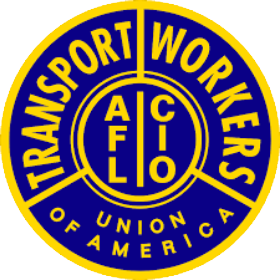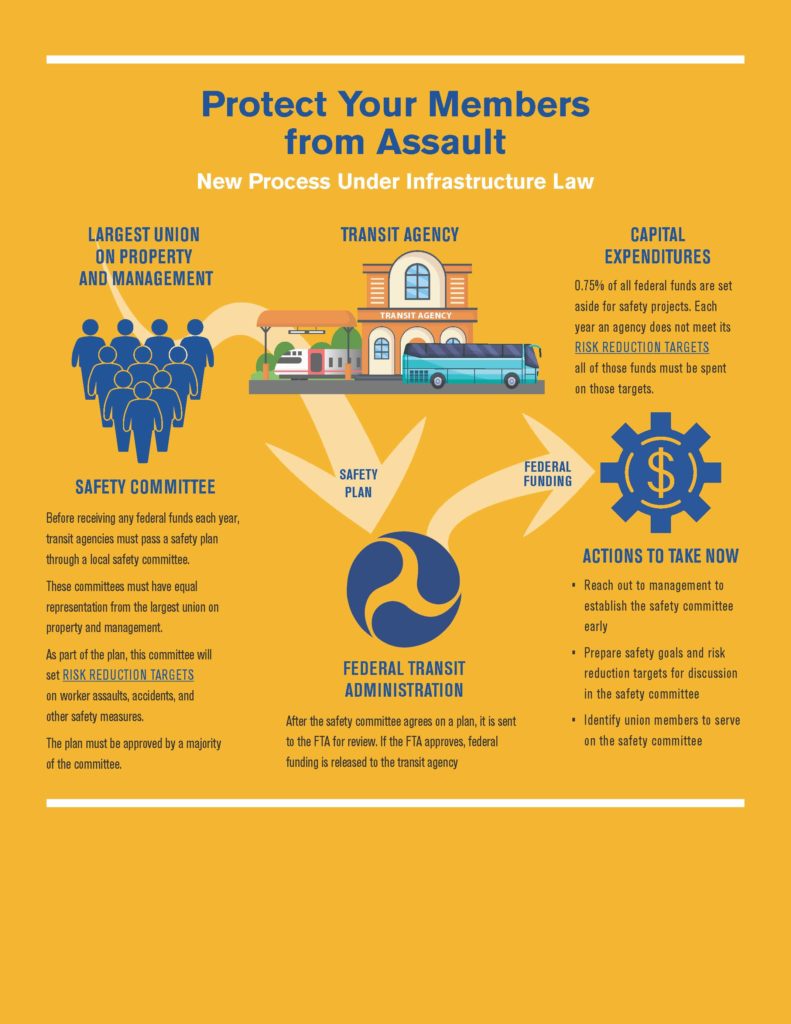FAQs on the Transit Safety Changes
in the Infrastructure Bill
What changes were made to transit safety under the new infrastructure bill?
The Infrastructure Investment and Jobs Act (IIJA, also known as the Bipartisan Infrastructure Bill – BIL) made several important changes to transit safety, all with workers’ concerns top of mind. The IIJA:
- Requires transit safety plans be written by a safety committee composed of an equal number of representations from Labor and management
- Creates a federal definition for “assault on a transit worker” and requires transit agencies to collect and report data under this new definition
- Directs the Federal Transit Administration to update the National Transit Safety Plan to reduce the number and severity of assaults in the transit system
- Establishes risk reduction measures for transit safety and requires agencies to build risk reduction targets using these measures
- Sets aside 0.75% of federal formula funds at each transit agency for safety investments
What actions do local unions need to take immediately to help implement these changes?
Every TWU local should reach out to transit agency management as soon as possible to begin the process for forming their local safety committees. Each local will need to decide, in coordination with management, the number of members on the safety committee, when and where they will meet, and any process issues for these discussions (similar to the initial round of contract bargaining).
Additionally, locals should identify individuals they want to serve on their safety committee, as well as determine which safety issues are most important to address through this process and what their risk reduction targets should be for 2023.
What will the Safety Committees do?
The Safety Committee’s primary responsibility at each transit agency will be drafting the agency’s Public Transportation Agency Safety Plan (PTASP) each year. The PTASP is then sent to the FTA for review and approval before the agency can receive any federal funding. This plan must be reviewed and resubmitted each year. If the Safety Committee cannot complete a safety plan, the agency is ineligible for federal formula funds, grants, and other federal aid.
How will the Safety Committees be formed?
There is not a standard for how a committee will be formed. Committees will be created at each transit agency using whatever process the agency and the union agree to. As long the committee is composed of an equal number of representatives selected by management and Labor, the committee can begin its work.
Who will be on the Safety Committees?
Under section 30018 of the IIJA, the union with plurality of frontline transit workers at each transit agency will choose 100% of the representatives from Labor (though the individuals the union selects do not need to be members of the union). Transit agency management will select their representatives. The individuals serving on the committee should have a working knowledge of safety issues, both in transit generally and at the local agency.
When do the Safety Committees have to be formed? When do they need to complete their work?
The FTA has announced that all safety committees must be formed no later than July 31, 2022. The committees have until December 31, 2022 to complete the initial update of the transit agency’s safety plan. Beginning January 1, 2023, each safety committee will need to review and update their plans annually.
What topics will be covered by the public transportation agency safety plan?
The safety plans are intended to identify and reduce risks to safety across the entire public transportation system. Any topic that would increase the safety of workers, riders, or others in and around public transportation (e.g., cars, pedestrians, road infrastructure, etc.) can be included in the plan.
At a minimum, these safety plans must address:
- Mitigating assaults on transit workers
- Reducing vehicular and pedestrian accidents involving buses
- Minimizing workers’ and riders’ exposure to infectious diseases
- Safety performance criteria and state of good repair standards for all equipment and infrastructure
- Training plan(s) for workers with safety responsibilities; these plans must include recurrent/continuing training and de-escalation training
- Establishing risk reduction targets (see above for more details)
What are the “risk reduction measures” and “risk reduction targets”?
The FTA will establish a set of risk reduction measures that safety committees can use to evaluate safety improvements or worsening conditions. The Safety Committees can then use these measures to set targets with the goal of improving safety in the system each year. Agencies that fail to meet the targets in any given year will be required to spend 0.75% of their federal formula funds on investments that will directly address these targets.
For example, a safety committee could set a risk reduction target of 0 assaults on transit workers for the year. If a worker is assaulted over the course of that year, the following year the agency would be required to spend 0.75% of its federal formula funds on investments designed to protect workers from assault.
Until the FTA establishes the official risk reduction measures, safety committees are free to choose their own measures and set their own targets as part of the safety plan.
What is the new definition of “assault on a transit worker”?
Going forward, transit agencies will have to report assaults on transit workers separate from other assaults in their system. This must include all incidents that meet the following definition:
The term “assault on a transit worker” means a circumstance in which an individual knowingly, without lawful authority or permission, and with intent to endanger the safety of any individual, or with a reckless disregard for the safety of human life, interferes with, disables, or incapacitates a transit worker while the transit worker is performing the duties of the transit worker.
All locals should encourage their management to begin collecting and sharing data under this definition immediately.
Other Resources
GET EMAIL UPDATES
Get latest news, event information, updates, and more.

